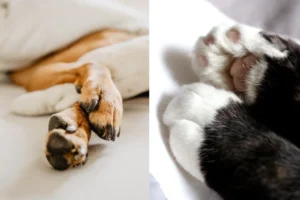Cats are known for their soft fur, sharp claws, and mysterious behaviors. But have you ever wondered why cats have extra pads on their paws? Let’s find out the fascinating reason behind this unique feline feature.
Cats have extra pads on their paws to provide cushioning, protection, and traction. These specialized pads help cats navigate various terrains, maintain balance, and silently stalk their prey. The extra padding also aids in absorbing shock and supporting their body weight, making it easier for cats to climb, jump, and hunt effectively.
Evolutionary Advantage
Cats have extra pads on their paws that serve a variety of purposes, all of which give them a competitive edge in the wild. These extra pads help cats navigate different terrains, from soft carpets to rough tree bark, with ease and agility.
Additionally, the extra pads provide cushioning and protection , enabling cats to walk, run, and jump without discomfort or injury. This evolutionary advantage allows cats to be stealthy predators and successful hunters, as they can move silently and quickly to catch their prey.
Over time, cats have evolved to have these extra pads as a way to enhance their survival skills and ensure their ability to thrive in various environments. Their unique paw structure has become a defining feature of these agile and graceful creatures, setting them apart from other animals in the animal kingdom.
Importance of Sensory Functions
The sensory functions of the extra pads on cats’ paws play a crucial role in how these feline friends interact with their surroundings. These specialized pads contain sensory receptors that provide cats with essential information about their environment, such as texture, temperature, and even vibrations.
By using these sensory functions, cats can navigate their environment with precision and grace , ensuring they can move confidently and comfortably across different surfaces. Their sensitive pads allow them to detect subtle changes in their surroundings, giving them a heightened sense of awareness and control.
In addition to aiding in movement and balance, the sensory functions of their extra pads also contribute to their grooming behavior, as cats use their paws to clean and groom themselves meticulously. This self-care routine is essential for their overall health and well-being.
In conclusion, the extra pads on cats’ paws not only provide them with a competitive advantage in the wild but also enable them to interact with their environment in a unique and purposeful way. These specialized pads are a fundamental part of what makes cats such fascinating and adaptable creatures.
Adaptation to Different Surfaces
Cats have extra pads on their paws that serve various useful purposes, one of which is assisting them in adapting to different surfaces. These extra pads act as shock absorbers and provide traction when navigating diverse terrains. Whether it’s the soft comfort of a carpet or the rough, rocky surface of a hiking trail, these specialized pads help cats maintain balance, avoid slipping, and move with ease. This unique adaptation allows them to explore their surroundings confidently, whether indoors or outdoors, without fear of losing their footing.
Moreover, these extra pads contain sweat glands that help regulate body temperature and provide moisture for better grip on surfaces. This versatile feature enables cats to roam effortlessly from one environment to another, showcasing their agility and adaptability. So, next time you observe your feline friend effortlessly maneuvering across different surfaces, remember that their extra pads play a crucial role in ensuring their comfort and stability.
Role in Grooming
In addition to aiding cats in traversing various terrains, their extra pads also play a significant role in grooming. During grooming sessions, cats utilize these pads to meticulously clean themselves, ensuring their fur remains free of dirt, debris, and excess oils. The unique texture and design of these pads allow cats to reach every nook and cranny of their fur, even in hard-to-reach areas.
By licking their extra pads and then using them to scrub their fur, cats effectively remove any unwanted particles and maintain their hygiene. This grooming process not only keeps their coat shiny and healthy but also stimulates blood flow and distributes natural oils, promoting overall skin health. Therefore, the next time you catch your cat meticulously grooming itself, appreciate the vital role their extra pads play in keeping them clean and well-groomed.
Additional Insight: Through grooming, cats also ingest loose fur that may accumulate on their paws, which helps prevent hairballs and aids in their digestion. So, beyond grooming for cleanliness, cats’ extra pads serve a dual purpose by assisting in their digestive health as well.
Impact on Climbing Abilities
Cats have extra pads on their paws that play a crucial role in enhancing their climbing abilities. These extra pads provide additional traction, allowing cats to grip onto various surfaces effortlessly. When a cat is scaling a tree or a fence, these extra pads help distribute their weight evenly, preventing slips and falls. This unique feature gives cats the agility and stability needed to navigate complex terrains with grace and precision. So, the next time you see your feline friend effortlessly climbing up a tall structure, remember, it’s all thanks to those extra pads on their paws.
Connection to Communication
Beyond aiding in climbing, the extra pads on cats’ paws also serve as a means of communication with other felines. Cats use scent glands located in these pads to leave behind pheromones, marking their territory and communicating with other cats in the area. This scent marking behavior helps establish boundaries and convey important messages about dominance, mating readiness, or simply letting other cats know they’ve been there. So, next time you notice your cat kneading or scratching a surface, they might just be leaving behind a message for their feline friends in the neighborhood.
- List:
- Cats use the scent glands in their extra pads to rub against objects, leaving their unique scent behind.
- The pheromones released through scent marking help cats establish a familiar environment and reduce stress.
- By scratching surfaces with their extra pads, cats are not only sharpening their claws but also spreading their scent to claim their territory.
Remember, the remarkable abilities of cats, from their climbing prowess to their communication skills, are all tied to those extra pads on their paws. These unique features not only showcase the incredible adaptability of felines but also highlight the intricate ways in which they navigate their environment and interact with one another.
Unique Characteristics
Have you ever noticed those little extra pads on your feline friend’s paws and wondered what they’re for? Well, these pads, known as “carpal pads,” serve a unique purpose. They provide extra traction for climbing and jumping, helping your cat navigate various surfaces with ease. These remarkable pads are like built-in grippy socks for your cat, allowing them to explore their environment efficiently and without any slips or slides. So, the next time you see your cat effortlessly scaling a tree or leaping to high places, remember to thank those incredible extra pads!
Here’s an interesting tidbit: these carpal pads are not the only special feature on a cat’s paw. Cats also have scent glands located between their paw pads, which they use to mark their territory. These scent glands release pheromones when your cat scratches a surface, leaving behind their unique scent for other cats to detect. This behavior is a way for cats to communicate with each other, establishing boundaries and conveying information about their presence in the area. So, those extra pads not only help your cat move around gracefully but also play a crucial role in their social interactions with other felines.
Useful Tips
In addition to their fascinating extra pads, cats also have retractable claws that help protect these pads when not in use. It’s essential to provide your feline friend with suitable scratching posts to help them maintain healthy claws and pads. This ensures that their claws stay sharp for self-defense and hunting, while also keeping their paw pads in optimal condition. By offering your cat an appropriate outlet for scratching, you can prevent them from damaging furniture and carpets, as well as promote their overall well-being.
- Encourage your cat to use scratching posts by placing them in strategic locations around your home, such as near their favorite resting spots or by windows.
- Regularly trim your cat’s claws to prevent them from becoming overgrown and causing discomfort.
- Consider using cat-friendly nail caps to protect your furniture from scratching while allowing your cat to exhibit their natural behavior.
By understanding the importance of these extra pads on your cat’s paws and providing them with the right care, you can ensure that your feline companion stays happy, healthy, and active. Remember, those little pads may seem small, but they play a significant role in your cat’s life.
Alex, a passionate animal lover, has experience in training and understanding animal behavior. As a proud pet parent to two dogs and three cats, he founded AnimalReport.net to share insights from animal experts and expand his knowledge of the animal kingdom.




